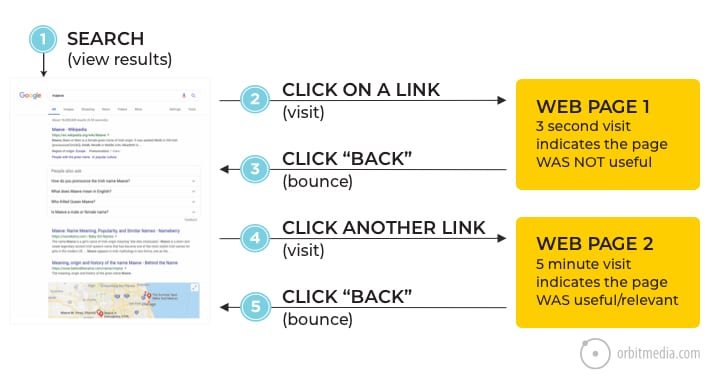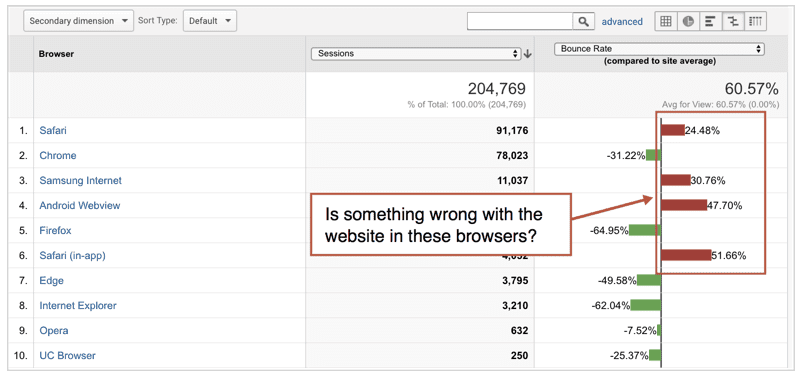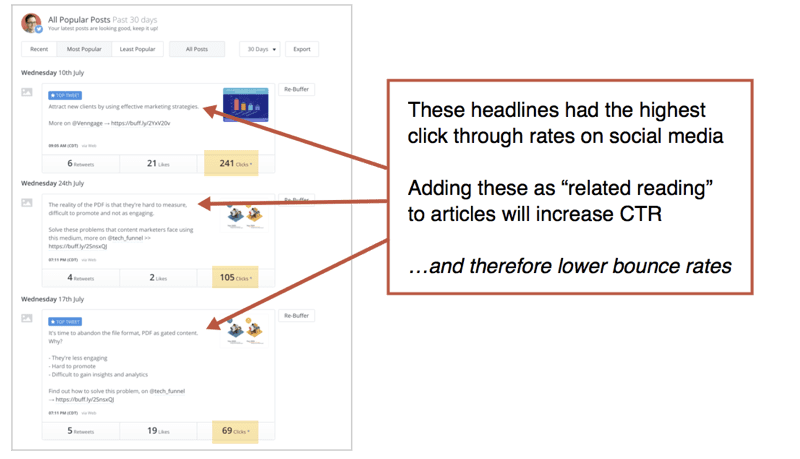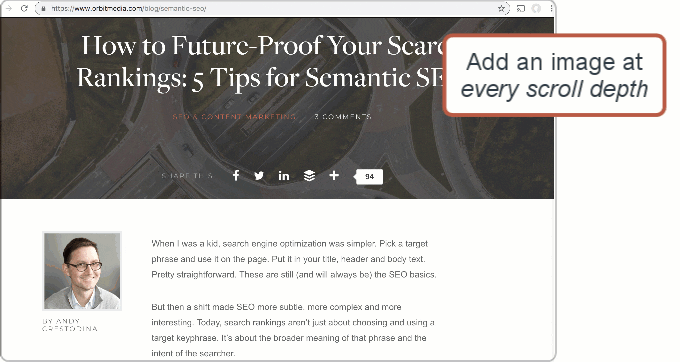It’s one of the most talked about metrics in digital marketing. Everyone hates bounces and everyone wants to reduce their bounce rate. Because bounces are bad, right?
But since most marketers have access to just one Analytics account, there isn’t much to compare it to. Is my bounce rate too high or too low?
So here’s a look at the famous bounce. We’ll explain what it really means and how it’s calculated. When it matters most and when it’s way off. And finally, we’ll share a list of ways you can lower your bounce rate. Because that’s never a bad thing.
What are bounce rates in Google Analytics?
Let’s start with the definition. Because it’s not obvious what bounce rate means. There’s what people think it is…
– A bounce is a one-page visit
And here’s what it really is…
– A bounce is a one-hit session
A session is a visit. Same thing. So that part is just semantics. But what’s a hit? And how is a hit different from a visit?
A hit is an interaction that causes data to be sent to Analytics. Pageviews are hits, but so are most events. Later in this post, you’ll see how issues with Javascript and use of events can really screw up your bounce rate.

Note about Analytics terminology: the words session and visit are interchangeable. Same thing.
So the true definition of a bounce is a one-hit visit. That’s the same as a one-page visit if there are no events set up on the page. Events are a way to track interactions on websites, other than pages loading, such as video play button clicks. And those events affect bounce rates we’ll see later on.
So the definition of bounce rate is the percentage of visits that were one-page visits. How are bounce rates calculated: Here’s the calculation: the number of one-page visits divided by the total number of visits.
Is bounce rate important?
Not necessarily. Here comes the debate:
- Why bounce rates are important.
- When do they matter in digital marketing.
- When we should all stop worrying about them.
The importance of bounce rates depends on the type of page and the traffic source.
Bounce rates are very important when…
- The page is a sales page, ecommerce product page or any page where the visitor has commercial intent such as landing pages, homepages and service pages
- The traffic was paid for: PPC, display or paid social
When traffic is expensive, the bounce rate is a measurement of waste. What percentage of these visitors that you bought is leaking away?
 |
ayat shukairy, Co-founder, invesp“We notice that bounce rate on ecommerce sites varies based on the type of landing page: when it comes to e-commerce for instance, optimized product pages have bounce rates close to 30% while optimized category pages typically have a bounce rate around 20%. Why does this difference exist? When visitors land on product pages for an ecommerce site, they only see one product. They might not like the price if they are price shopping, the fact that there are not enough reviews on the site might turn them off, or they may not trust the site altogether. On category pages, visitors see multiple products. So, the site has a higher chance of persuading the visitor to stay on the site.” |
Bounce rates really don’t matter when…
- The page is an article or any page where the visitor has information intent such as blog posts. AND…
- The traffic source was free: SEO or social media.
But when traffic is free, the bounce rate is simply the percentage of people who didn’t need anything else and weren’t motivated (or triggered) to click again. They wanted information, they got it and left. What else did you expect?
Related reading: The Two Kinds of Website Visitors
This doesn’t mean that we shouldn’t always work to lower our bounce rates. At the end of this post, you’ll find a list of ways to do just that.
What’s a good bounce rate?
Here is a breakdown of the types of sources of traffic and importance of bounce rate. From our recent research, we added a benchmark to try to answer the biggest questions:
- What is a good bounce rate?
- What is a good bounce rate by traffic source?
- What’s a good bounce rate by industry?


You can read the full bounce rate benchmark report here.
Note: For media companies with advertising models, your goal to reduce your bounce rate is in direct conflict with the goals of your advertisers. They want your visitors to bounce over to them. That’s why they pay you. Native advertisers are masters of increasing bounce rates.
 |
Oli Gardner, Co-founder, Unbounce“In all the landing page research we’ve done at Unbounce regarding bounce rates and conversion, the one data point I love the most is that the highest converting pages, which conversely people almost never bounce from, are email opt-out landing pages 😂. Gotta love the motivation to get off a shitty email list.” |
How do bounce rates affect SEO? They don’t.
Google knows the bounce rates of our pages. They own the most popular browser, the most popular operating system and the most popular web analytics tool. Do they use bounce rates as a search ranking factor? A lot of marketers believe they do.
But is bounce rate really a ranking factor in SEO? Let’s look at some data.
Here are the top landing pages from search on this website. It’s the Behavior > Landing Pages report with a Source/Medium secondary dimension showing google/organic. The top organic landing pages have an average bounce rate of 83%.
That’s high, right? How is this possible if bounce rate is a search ranking factor?

This suggests that bounce rates have nothing to do with your rankings. If you doubt this, check your own Analytics. If your data suggests otherwise, please share.
It makes sense. Google wants to give visitors answers. And once a visitor gets an answer, they’re likely to leave. Information needs have been met. Time to bounce.

Then which user interaction signals are search ranking factors? Probably dwell time and “pogo sticking”.
How to check your bounce rates
Where to find this number? It’s easy to find. It’s everywhere. Here are some of the many places in the Acquisition and Behavior sections.
- For the entire website …but aggregate data is always the least meaningful
- For any specific page …measures the percentage of people who didn’t click through to subsequent pages when that page was the first page of the visit
- For any traffic source …measures the percentage of people who didn’t click through to see more than one page
- For any traffic source for any specific page …add a secondary dimension (source/medium) to the Behavior > Site Content > All Pages report to see who is most (or least) likely to go deeper into your website.
As usual, the closer you look, the more likely you are to find insights. You can also find bounce rates in the Audience section, where mobile and technology reports are found.
Pro-Tip! The bounce rate for browsers may give you quick clues about browser-compatibility issues (CSS and Javascript). Switch this report to the comparison view with bounce rate set as the metric and outliers will jump out at you. Go check your site in those browsers!

In that example, bounce rates may have helped you find and fix a critical flaw. But most of the conversations we have about bounce rates are not as practical.
Accuracy issues: Why is my bounce rate so low? So high?
Bounce rates are never truly accurate. In fact, every number in your Analytics is wrong. All traffic is underreported because not every visitor accepts cookies, especially in the GDPR era.
[ctt template=”3″ link=”8B723″ via=”yes” ]Bounce rates are never truly accurate. In fact, every number in your Analytics is wrong. [/ctt]
But bounce rates have specific issues, starting with the Analytics timeout. If you stay on this page for 31 minutes and the click, you are recorded as a bounce, even though you may have been super engaged.
30 minutes is the default session timeout period. You can change this in Property Settings > Tracking Info > Session Settings, but that doesn’t really solve the problem.

Other issues include people who leave tabs open, pages that launch new tabs. Or what about pages that send visitors to third party tools? Is a bounce even a bad thing?
Example: Want to go to an event? Search for an event, land on an event detail page, click to register and you land on Eventbrite page. You’re a super engaged visitor, converting into a registrant …and a bounce.
But bounce rates have their own special issues in Analytics…
Why is my bounce rate 0%? Why is it so low?
Remember, a bounce is a one-hit session, not a one-page visit. So if there are two hits on the same page, there’s no bounce, even if those hits happen the moment the page loads. Here’s what it looks like.
![]()
There are two likely reasons for this:
- Analytics tracking code is on the page twice (maybe Google Tag Manager was added but the original Analytics tracking code wasn’t removed)
- An event is being triggered right after the page loads (maybe someone set up scroll tracking or a session duration event)
If it’s an event, you can solve the problem by setting the event as a non-interaction hit, which is easy if the event was created in Google Tag Manager. It’s a dropdown in the tag configuration. Set it to true and it will stop affecting your bounce rate.
![]()
Why is my bounce rate 100%?
It’s either a bot (which isn’t real traffic) or because you have a one page website. If your homepage is long and your navigation sends visitors down to specific sections, then the URL in the address bar doesn’t change as the visitor uses the site.
Your bounce rate will be 100% because every visit is just one page. Your site is terrible for both Analytics and for SEO.
Want a more meaningful number? Set up “adjusted bounce rate” using the 5-second rule
Bounce rate is an engagement metric, but it doesn’t take into account how long someone spends on a page. If a visitor reads a page for 5 minutes and then hits the back button, that’s very different from a visitor who spends 5 seconds on the page and leaves.
But these two visits look the same in Analytics.
This is why digital marketers set up “adjusted bounce rates” that factor in both the one-page visit with the time on page. It combines bounce rate with a timed event (usually a time period of 50000 milliseconds or 5 seconds) to show a more meaningful number: the percentage of visitors who see just one page AND spend less than 5 seconds on that page.
 |
angie schottmuller, keynote speaker, growth marketing advisor“Ain’t nothing sadder than hosting a party and having guests walk away at the door. If a user doesn’t stay at least 5 seconds, your content party sadly sucks. For both SEO and conversion, I target adjusted bounce rates under 10%. If higher than that, it’s critical to audit message match (ad/search/dovial/email snippet vs actual page) for copy and visuals along with load time. Tip: Use “Default Channel Grouping” as a GA secondary dimension to identify specific channel culprits. Sometimes an embedded image or video can leave a white space gap while loading that confuses users. Use webpagetest.org to audit “first-view load time” (media isn’t cached) and watch the loading progression for flickers or delays.” |
You can find instructions for setting this up using Google Tag Manager here.
How to reduce bounce rates: 5 ways to improve engagement
Bounce rates are important. Regardless of the number, the page, the traffic source, it’s always good to get this number down. So let’s wrap with a list of five ways to push that number down and bring engagement up
1. Improve click through rate by leveraging your highest CTR headlines
Turn the question around and instead ask “how can I increase the click through rate to the next page?” That’s really what you’re trying to do.
To reduce the bounce rate of an article, add your highest CTR headline as a call to action for suggested reading. If you’re using headline best practices, you should have quite a few of these. And if you’ve promoted content in social media, you should have insights into which headlines have the best engagement.
Here I’ve gone into Buffer, which we sometimes use for social scheduling. The Analytics tab has a “most clicks” filter. It shows you which social posts got clicked the most. These are your bounce stoppers.

Jump into WordPress and add inject these into articles one-third down from the top and again at two-thirds down. Adding them at the end won’t help because your visitors are bouncing before they get there.
2. Formatting, Scan-ability
If the top of your post is a wall of text, with a big blocky paragraph, then it’s no wonder they leave immediately. But if you welcome them into your article with a friendly image and some short, easy to scan paragraphs, they’re more likely to stay.
Go back and check the 21-point web content checklist. The human psychology section has some ideas for you.
3. Make your content more visual: add image and visuals
It’s no wonder that Facebook, Instagram and YouTube have such high engagement rates (and low bounce rates). They are filled with visual content. Adding images to articles, especially near the top, can keep visitors engaged.

Add images throughout the page, giving the reader something of visual interest at every scroll depth. The longer they stay on the page, the more likely they are the see and click on a link.
4. Remove dates from your blog
This recommendation triggers a bit of backlash. Yes, readers will tell you they prefer to know the date something was written. I completely understand. But any indication that an article is old will reduce the likelihood that visitors will stay, engage, read and click deeper.
This only makes sense if the content strategy is to publish evergreen content that time-travels well. It is not for content programs that publish news.
It also commits the marketer to update older articles to keep them relevant, which you should do anyway for these reasons.
So remove dates from your blog post template. It helps your content age gracefully. And if you ever need to add a date (maybe to timestamp your research) just add the date to the headline or in the editorial.
5. Increase traffic from low-bounce traffic sources
Traffic from some sources are more likely to bounce than others. So any increase in traffic from low-bounce rate sources will lower the overall bounce rate. So if visitors from search are less likely to bounce, promote the content in that channel.

How was your visit? Want to see another page?
If you gotta bounce, we completely understand. If you’d like more insights into visitor behavior and Analytics, visit a second page by clicking one of these fine links…





